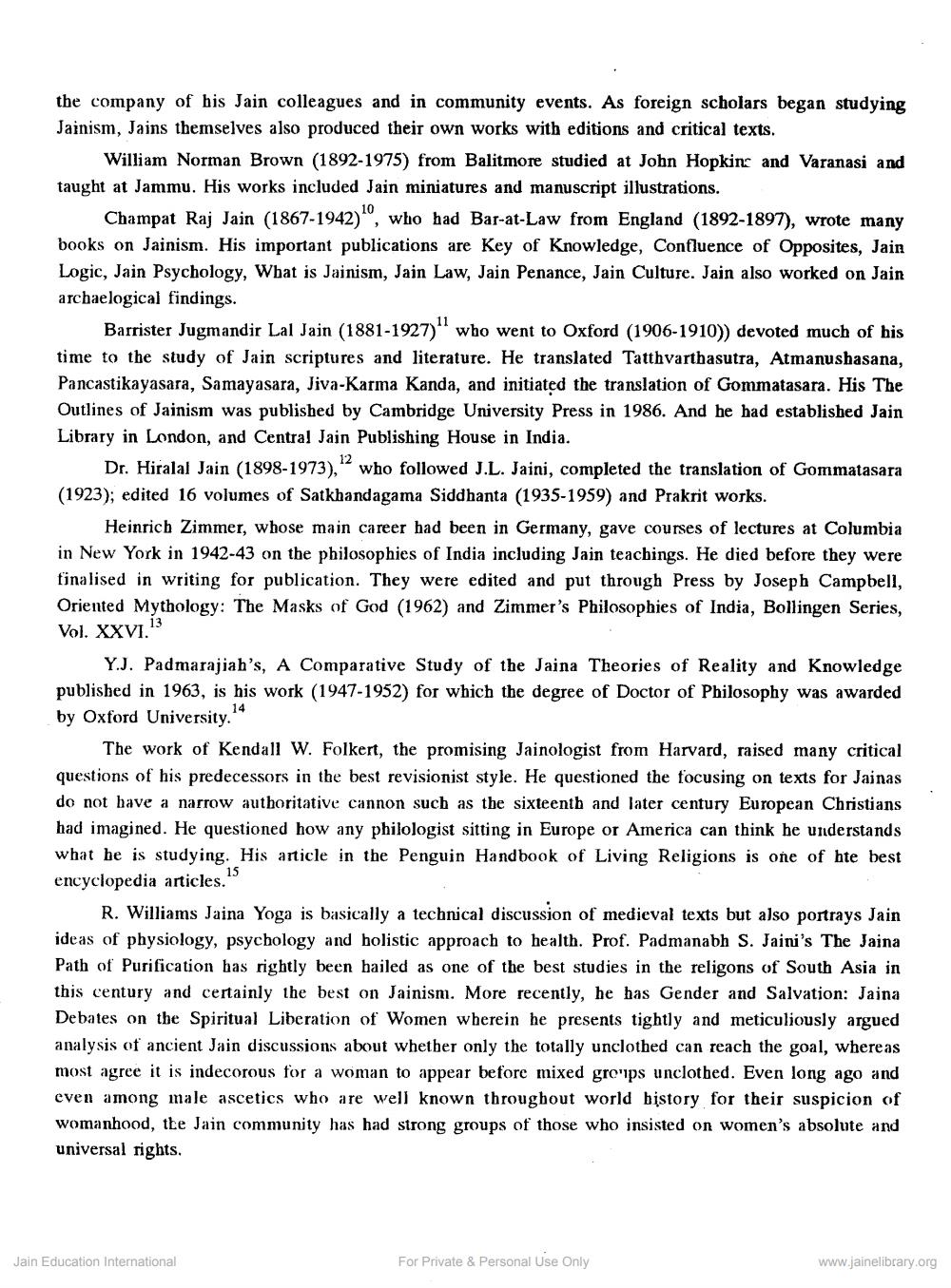________________
the company of his Jain colleagues and in community events. As foreign scholars began studying Jainism, Jains themselves also produced their own works with editions and critical texts.
William Norman Brown (1892-1975) from Balitmore studied at John Hopkins and Varanasi and taught at Jammu. His works included Jain miniatures and manuscript illustrations.
Champat Raj Jain (1867-1942)", who had Bar-at-Law from England (1892-1897), wrote many books on Jainism. His important publications are Key of Knowledge, Confluence of Opposites, Jain Logic, Jain Psychology, What is Jainism, Jain Law, Jain Penance, Jain Culture. Jain also worked on Jain archaelogical findings.
Barrister Jugmandir Lal Jain (1881-1927)" who went to Oxford (1906-1910)) devoted much of his time to the study of Jain scriptures and literature. He translated Tatthvarthasutra, Atmanushasana, Pancastikayasara, Samayasara, Jiva-Karma Kanda, and initiated the translation of Gommatasara. His The Outlines of Jainism was published by Cambridge University Press in 1986. And he had established Jain Library in London, and Central Jain Publishing House in India.
Dr. Hiralal Jain (1898-1973)," who followed J.L. Jaini, completed the translation of Gommatasara (1923); edited 16 volumes of Satkhandagama Siddhanta (1935-1959) and Prakrit works.
Heinrich Zimmer, whose main career had been in Germany, gave courses of lectures at Columbia in New York in 1942-43 on the philosophies of India including Jain teachings. He died before they were finalised in writing for publication. They were edited and put through Press by Joseph Campbell, Oriented Mythology: The Masks of God (1962) and Zimmer's Philosophies of India, Bollingen Series, Vol. XXVI."
Y.J. Padmarajiah's, A Comparative Study of the Jaina Theories of Reality and Knowledge published in 1963, is his work (1947-1952) for which the degree of Doctor of Philosophy was awarded by Oxford University."
The work of Kendall W. Folkert, the promising Jainologist from Harvard, raised many critical questions of his predecessors in the best revisionist style. He questioned the focusing on texts for Jainas do not have a narrow authoritative cannon such as the sixteenth and later century European Christians had imagined. He questioned how any philologist sitting in Europe or America can think he understands what he is studying. His article in the Penguin Handbook of Living Religions is one of hte best encyclopedia articles."
R. Williams Jaina Yoga is basically a technical discussion of medieval texts but also portrays Jain ideas of physiology, psychology and holistic approach to health. Prof. Padmanabh S. Jaini's The Jaina Path of Purification has rightly been hailed as one of the best studies in the religons of South Asia in this century and certainly the best on Jainism. More recently, he has Gender and Salvation: Jajna Debates on the Spiritual Liberation of Women wherein he presents tightly and meticuliously argued analysis of ancient Jain discussions about whether only the totally unclothed can reach the goal, whereas most agree it is indecorous for a woman to appear before mixed groups unclothed. Even long ago and even among male ascetics who are well known throughout world history for their suspicion of womanhood, the Jain community has had strong groups of those who insisted on women's absolute and universal rights.
Jain Education International
For Private & Personal Use Only
www.jainelibrary.org




